
Floodgates and retention structures: choosing the right design
There are two simple ways to improve drain water quality and reduce acid water flowing into rivers. You can open floodgates and let river water into the drain, or you can retain very acid water to prevent it from flowing into the river. This leaflet describes the main designs for floodgate opening devices and retention structures, and outlines their advantages and disadvantages.
Floodgate opening devices
Tidal floodgates
Various designs exist. They usually consist of an aperture within the existing floodgate with another smaller floodgate attached. A floating arm opens the gate and allows water exchange with each tide. The gate opens on the low tide and closes with the rising tide.
Water level control: Control is very good as the float arm can be adjusted to stop inflow at the desired water level.
Advantages: Automatic operation of the gate by the tide. Excellent water level control. The amount of exchange and maximum height of tidal influence on the inside water level can be adjusted. This design is flood secure and automatically closes as outside water level rises.
Disadvantages: There is a minor risk of being jammed open (as with normal gates). May require a new gate to be made in some cases.
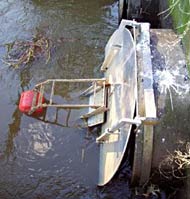
Sluice gates
Sluice gates consist of an aperture within existing floodgate with a sliding plate cover that can be opened to varying degrees. This opening can be vertical, horizontal or rotational in design.
Water level control: The aperture size can be adjusted to vary the amount of inflow to suit site conditions so water level control is good. The position of the aperture in the floodgate can also be varied and will affect water level control.
Advantages: The variable aperture size means sluice gates provide excellent water level control. The simple design is low cost and low maintenance.
Disadvantages: Requires manual operation and manual closure in floods.
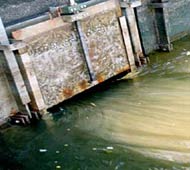
Winch gates
Various designs exist including, a) winch and cable mechanism which allows the existing floodgate to be lifted open either horizontally or vertically and b) a worm drive mechanism that opens the gates vertically.
Water level control: Depends on the design. Horizontal winch gates have limited water level control and are either fully open or closed. Vertical lift gates have good water level control and can be set in any position, from fully closed to fully open.
Advantages: Winch gates can allow large, rapid inflows of river water and can be fully raised to assist outflow after flooding.
Disadvantages: These gates require intensive manual operation and manual closure in the event of flooding. Horizontal winch gates have a greater risk of causing overtopping when open. Large forces can be involved in winch and cable system. Vertical winch gates can experience closing difficulties due to friction.
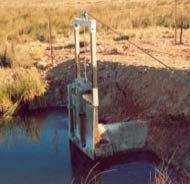
Retention structures
Weirs / fixed sill
Weirs and fixed sills consist of a partial block in the drain. A variety of designs exist and many materials can be used (i.e. sandbags, rock/fill, concrete, steel).
Advantages: Weirs and sills provide an ability to retain a guaranteed minimum water level. There is potential to vary the depth of water retention depending on the design (i.e. to retain only groundwater or to retain shallow surface water). These structures are generally low maintenance and low cost, depending on materials.
Disadvantages: It may be difficult to vary the minimum water level once installed, depending upon the design. They can be difficult to remove from drain, again depending on design and materials.
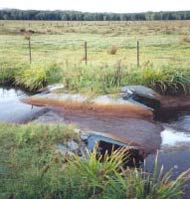
Penstocks
These are a sluice gate or vertical lift gate placed on the landward side of a culvert.
Advantages: Penstocks provide a good seal, good water level control and rarely fail. They are low maintenance if made from stainless steel.
Disadvantages: They can be expensive. They are manually operated and can jam open during outflow periods if they are the vertical winch type design. A screw thread design prevents this.
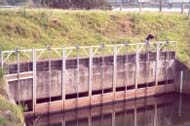
Dropboard culverts
This simple design consists of boards placed in slots in front of any culvert on the landward side.
Advantages: Water level depth can be adjusted to a desired level. Low cost.
Disadvantages: They are manually operated and the boards can be difficult to remove under a significant head of water. They are suitable only for low volume drains. They often have some leakage between the boards.
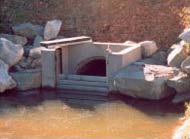
Choosing the right design
The type of floodgate opening device or retention structure you choose depends on your drainage system and management objectives. All stakeholders in the system need to be consulted before doing any works. Remember that retention structures will impede fish moving upstream, so these should only be used where there is significant benefit - such as reducing acid water flowing into the river.
It is important to match any works with the characteristics of the drainage system, so it is essential to conduct a thorough site assessment. This will help to determine what style of management the drainage system is best suited to. Various state and local government organisations have expertise in this kind of assessment and can be contacted for assistance.
Further information
For further information, advice and assistance on floodgate and drain management contact NSW DPI.
Citation: Johnston S,Floodgate and drain management on coastal floodplains leaflet 6: Floodgates and retention structures - choosing the right design. (NSW Agriculture: Wollongbar)

